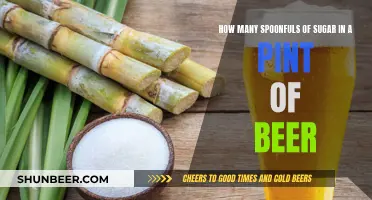
Tempura batter and beer batter are both used for deep-frying foods, but they have some key differences. Tempura batter typically consists of flour, cornstarch, and ice-cold carbonated water, resulting in a light, lacy, and ultra-crispy coating. On the other hand, beer batter uses beer as the main liquid ingredient, adding carbon dioxide, foaming agents, and alcohol to the mix, creating a puffier and crunchier texture. While both batters are similar, the addition of beer enhances the flavour and texture of the final product.
What You'll Learn
- Tempura batter is made with flour and carbonated water, while beer batter contains beer, flour, salt, and paprika
- Beer batter puffs up more when frying due to carbonation, giving a fuller crunch
- Tempura batter is light, lacy, and ultra-crispy, ideal for deep-frying vegetables and seafood
- Beer acts as a better base for batter as it adds carbon dioxide, foaming agents, and alcohol
- Authentic tempura batter mixes are flavour-neutral and will stay light and crispy for over 60 minutes

Tempura batter is made with flour and carbonated water, while beer batter contains beer, flour, salt, and paprika
Tempura batter and beer batter are both used for deep frying and can create a crispy finish. However, they have distinct differences in terms of ingredients and the results they yield.
Tempura batter is typically made with only two essential ingredients: flour and carbonated water. The carbonation in the water is key to achieving a light, airy, and puffy texture. The ice-cold water is crucial, as it prevents gluten formation and keeps the batter from becoming too thick. This results in a thin, watery consistency that coats the food item evenly. The batter is made in small batches and used immediately, ensuring a delicate and crispy final product.
On the other hand, beer batter contains a combination of beer, flour, and additional ingredients like salt and paprika. The beer acts as a leavening agent, with the carbon dioxide, foaming agents, and alcohol contributing to a light and crispy finish. The beer also adds flavour to the batter, enhancing the taste of the fried food. Unlike tempura batter, beer batter tends to create a thicker coating on the food.
The choice between tempura batter and beer batter depends on the desired outcome and personal preference. Tempura batter is known for its light and airy texture, making it ideal for seafood and vegetables. Beer batter, on the other hand, offers a fuller crunch and a more robust flavour, making it a popular choice for dishes like fish and chips.
While the two batters share some similarities, the differences in ingredients and cooking techniques lead to distinct results. By understanding these differences, cooks can choose the most suitable batter for their specific dishes, elevating the taste and texture of their fried creations.
Stout vs Porter: Unveiling Beer's Dark Secrets
You may want to see also

Beer batter puffs up more when frying due to carbonation, giving a fuller crunch
Beer batter and tempura batter are similar, but beer batter puffs up more when frying, giving a fuller crunch. This is due to the carbonation in the beer. The carbon dioxide in beer simultaneously adds carbon dioxide, foaming agents, and alcohol to the batter. These ingredients contribute different aspects of physics and chemistry, resulting in a light and crispy crust.
The carbonation in the beer makes the batter froth more in the oil, creating a lacier finish. The CO2 bubbles escape while frying, resulting in a super-crunchy crust. The crunchiness of the batter can be enhanced by using a siphon for more carbonation.
The temperature of the liquid also plays a role in the crunchiness of the batter. Carbon dioxide dissolves better in cold water and is released when it gets warmer. Therefore, it is essential to chill the beer or club soda before adding it to the batter.
Additionally, the type of flour used can impact the crunchiness of the batter. A combination of cake flour and cornstarch is often used to create a crispier texture.
Mexican Beers: Unique Flavors and a Cultural Legacy
You may want to see also

Tempura batter is light, lacy, and ultra-crispy, ideal for deep-frying vegetables and seafood
Tempura batter is perfect for deep-frying vegetables and seafood. The batter is light, lacy, and ultra-crispy, resulting in a coating that is both flavourful and texturally appealing. The key to achieving this light and airy texture is in the ingredients and the technique.
Firstly, the ingredients must be prepared correctly. The flour should be sifted to make it lighter and easier to incorporate into the batter. Ice-cold water is also essential, as the low temperature prevents gluten formation and ensures a crispier batter. The water's cold temperature also reacts with the leavening agent, such as baking soda, creating a lighter and crispier coating. Additionally, using chopsticks instead of a whisk to mix the batter minimises air incorporation and reduces the risk of overmixing.
When preparing the food for frying, it is important to cut the ingredients into bite-sized pieces. A light coating of flour on the food before dipping it into the batter helps the batter adhere better. It is crucial not to use too much batter, as this can result in a crispy exterior but a mushy interior. The frying oil temperature should be between 340°F and 360°F. Frying at a higher temperature will make the tempura too crispy, while a lower temperature will result in greasy, undercooked food.
Tempura batter is typically made with flour, egg, and ice water. Some recipes may include additional ingredients such as cornstarch, baking powder, and pepper. The absence of egg in some tempura batter recipes results in a crispier texture. The batter should be used immediately after mixing, as freshly made tempura batter produces the best results.
Exploring Diverse Beer Markets: A Global Perspective
You may want to see also

Beer acts as a better base for batter as it adds carbon dioxide, foaming agents, and alcohol
Beer is a better base for batter than tempura due to its composition. Beer contains carbon dioxide, foaming agents, and alcohol, all of which contribute to the desirable light and crispy texture of fried foods.
Carbon dioxide is a key ingredient in creating a crispy batter. When the batter is fried, the carbon dioxide escapes, creating a super crunchy crust. The carbonation in beer makes the batter puff up, resulting in a fuller crunch. This is especially noticeable in beer-battered vegetables, which benefit from the added crispiness.
The foaming agents in beer also contribute to the airy texture of the batter. The alcohol in beer evaporates during frying, ensuring that the batter does not become soggy or oily. This is a significant advantage, as it keeps the fried food light and crispy.
Additionally, the carbonation in beer creates a lacier finish on the batter, further enhancing its appearance and texture. The combination of carbon dioxide, foaming agents, and alcohol in beer results in a batter that is lighter, crispier, and more flavourful than traditional tempura batter.
While tempura batter typically uses carbonated water to create a similar effect, the carbonation in beer enhances the crunch and flavour, taking the dish to the next level. Thus, beer is a superior choice for creating a batter with a light, crispy, and airy texture.
EBC Beer Shipping: State-by-State Availability and Restrictions
You may want to see also

Authentic tempura batter mixes are flavour-neutral and will stay light and crispy for over 60 minutes
Authentic tempura batter is flavour-neutral and will stay light and crispy for over 60 minutes. The secret to its success lies in the ingredients and techniques used.
Firstly, the batter is typically made with ice-cold water or a carbonated liquid such as club soda, seltzer water, or beer. The cold temperature and carbonation prevent gluten formation, ensuring a light and crispy texture. The liquid is combined with flour, and in some cases, cornstarch, to create a thin batter. It is essential not to overmix the batter, as this can activate the gluten, making the batter heavier.
Additionally, the food items to be battered are lightly coated with flour or cornstarch before being dipped into the batter. This ensures the batter adheres well and helps create a crispy exterior. The oil temperature for frying is crucial, ranging between 340°F and 360°F. Too high, and the tempura will be overly crisp; too low, and it will absorb excess oil, resulting in a greasy mouthfeel.
Furthermore, tempura is best served immediately after frying. It is not advisable to prepare the batter ahead of time, as it yields inferior results. To maintain crispiness, it is recommended to use a wire rack for draining instead of paper towels, as the latter can cause steaming.
By following these guidelines, you can achieve the signature lightness and crispiness of authentic tempura batter, which can be enjoyed for a substantial duration.
Hard Cider vs Beer: What's the Difference?
You may want to see also
Frequently asked questions
Tempura batter is typically made with flour and carbonated water, while beer batter is made with beer and flour. Beer batter is puffier and crunchier due to the carbonation in the beer, whereas tempura batter is lighter and crispier.
Yes, you can use beer in tempura batter to create a "beer tempura batter". This will result in a crunchier texture than traditional tempura batter. However, it is important to add the beer gradually and chill the batter before frying.
When making tempura batter, it is important to use ice-cold water or carbonated water, and to add a leavening agent such as baking soda. The batter should be made in small batches and used immediately. For a crispier texture, you can add alcohol, such as vodka, to the batter.







